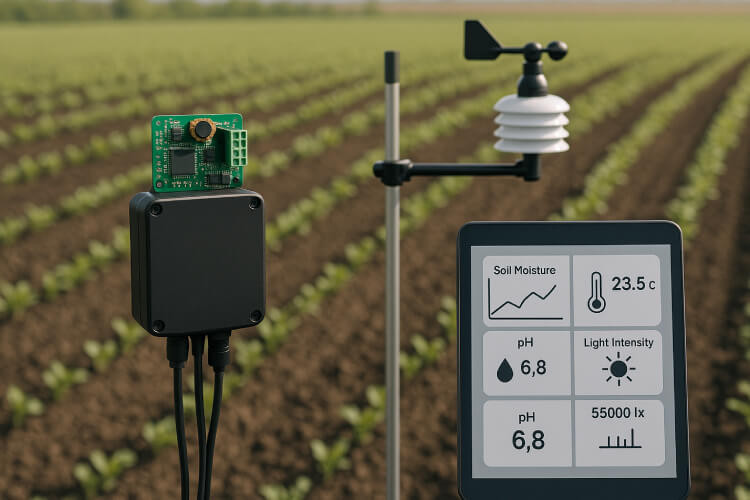Smart Farming MEMS Technology: Boosting Yields With Edge AI
Insights | 16-05-2018 | By Mark Patrick

Originally published 16-05-2018 | Revised June 2025
Key Takeaways:
- AR market surge: IDC values AR at US $83.6 bn (2024) and forecasts 38 % CAGR through 2030.
- Mainstream hardware: LiDAR-equipped phones plus Vision Pro, Quest 3 and smart-glasses deliver room-scale mixed reality.
- Real-world impact: Boeing, DHL, Mayo Clinic and IKEA report double-digit gains from industrial, logistics and retail AR.
- Richer toolchains: 8th Wall, Niantic Lightship and Reality Composer Pro let brands launch browser-based, AI-enhanced AR experiences.
In the last few decades, electronic measurement and analysis has been increasingly deployed to improve agricultural productivity.
This use of precision agriculture enables farmers to determine the amount of water, fertiliser, pesticides and weed-killers required for each micro-zone within a field. This can help increase yields while reducing environmental impact.
Real-time data gathering and analysis can also be used to monitor the status of soil, crops and livestock, providing early warning of any problems.
Smart-Farming Market Momentum – 2025 Update
When this article first ran, Markets & Markets expected global smart-ag revenues to reach US $11 billion by 2022. Reality has outpaced that projection. The firm’s 2024 revision shows the sector already at US $19 billion and on course to exceed US $32 billion by 2029—roughly 12 % CAGR. Complementary studies from IDC and Omdia echo the trend, highlighting double-digit growth in Latin America and sub-Saharan Africa as sensor prices fall below the US $10 threshold.
Several forces are fuelling the surge. Ultra-low-power MEMS sensors and sub-GHz LPWAN radios now ship in wafer-level packages that cost pennies, while nanosatellite constellations provide reliable backhaul for remote farms. Edge-AI modules based on Arm Cortex-M55 and RISC-V cores crunch data locally, slashing bandwidth needs by up to 80 %. On the policy side, EU Common Agricultural Policy (CAP) incentives, the U.S. Inflation Reduction Act’s climate-smart credits and a record US $6 billion in ag-tech venture funding (2024) are accelerating adoption. With ESG reporting requirements tightening and carbon-tracking demand rising, analysts expect momentum to continue well beyond the decade.
MEMS Technology
Much of the measurement and sensing required for agricultural applications depends on micro-electromechanical systems (MEMS). These combine mechanical structures with electronics to create smart-agriculture sensors, controllers and energy harvesters.
Their advantages—small size, low cost and low power—make MEMS ideal for distributed field deployment. Integrated electronics handle control, data gathering, self-calibration and wireless communication; on-board processing provides immediate feedback and reduces network traffic.
To be useful, devices must be low cost, easy to install and have multi-year lifetimes. Rugged housing and ultra-low-power operation allow them to run for years on batteries, solar cells or energy-harvesting systems.
MEMS sensors cover gyroscopes, accelerometers, magnetometers and devices for pressure, sound and humidity; they also underpin lab-on-a-chip (LOC) platforms.
A combined accelerometer/gyro such as the Murata SCC2000 can augment GPS by supplying terrain data for centimetre-accurate ploughing and seeding. Newer nine-axis IMUs like Bosch’s BMI323 add on-chip sensor-fusion, cutting MCU overhead and latency.
Accelerometers monitor livestock activity—time spent walking, eating or ruminating—which correlates with nutrition and health. Spikes in activity indicate oestrus; real-time alerts let farmers schedule insemination without guesswork.
During calving, products such as Moocall use tail-movement patterns to text the farmer roughly an hour before birth. Ear-tag sensors like Allflex SenseHub now send the same data over low-power LoRaWAN, covering multi-kilometre pastures without cellular fees.
MEMS modules also log temperature, humidity and noise to prove welfare standards—especially useful when animals are transported.
Lab-on-a-Chip Comes to the Field
LOC integrates one or more lab functions on a chip a few mm across. Cantilevers coated with selective receptors shift resonance when a pathogen binds, revealing its presence—and even its concentration. Other biochemical MEMS measure capacitance changes as molecules attach.
These devices enable automated, high-throughput screening with microlitre samples, bringing diagnostics to the farm instead of waiting days for a lab. Wageningen University recently demonstrated a soil-nitrate LOC delivering results in under three minutes, while start-ups such as Biotangents offer sub-hour mastitis detection cartridges for dairy sheds.
MEMS market outlook – 2025
Early projections saw the sector at US $19 billion by 2022. Yole Intelligence now pegs it at US $28 billion in 2024 and forecasts US $45 billion by 2030, with average selling prices still falling.
MEMS and IoT will be crucial in feeding a growing global population—boosting productivity while minimising ecological impact. As prices continue to drop, connected-agriculture benefits will reach farms of every size.
Read More:
Digitisation in Agriculture: Smart Farming with Greater Precision
Looks at cloud analytics, MEMS sensors and drone imaging that give farmers centimetre-level accuracy for water, fertiliser and pesticide use.
IoT and Agriculture: How Connected Sensors Are Revolutionising Farming
Explains how LPWAN nodes, smart gateways and edge data crunching cut waste, boost yields and bring real-time insights to remote fields.
Agricultural AI: Feeding a Hungry World with Machine Learning
Covers computer-vision crop scouting, predictive yield models and autonomous tractors that optimise inputs for global food security.
How Robotics and AI Will Change Agriculture
Surveys field robots, fruit-picking arms and weed-zapping drones that promise labour savings and sustainable, high-throughput farming.

